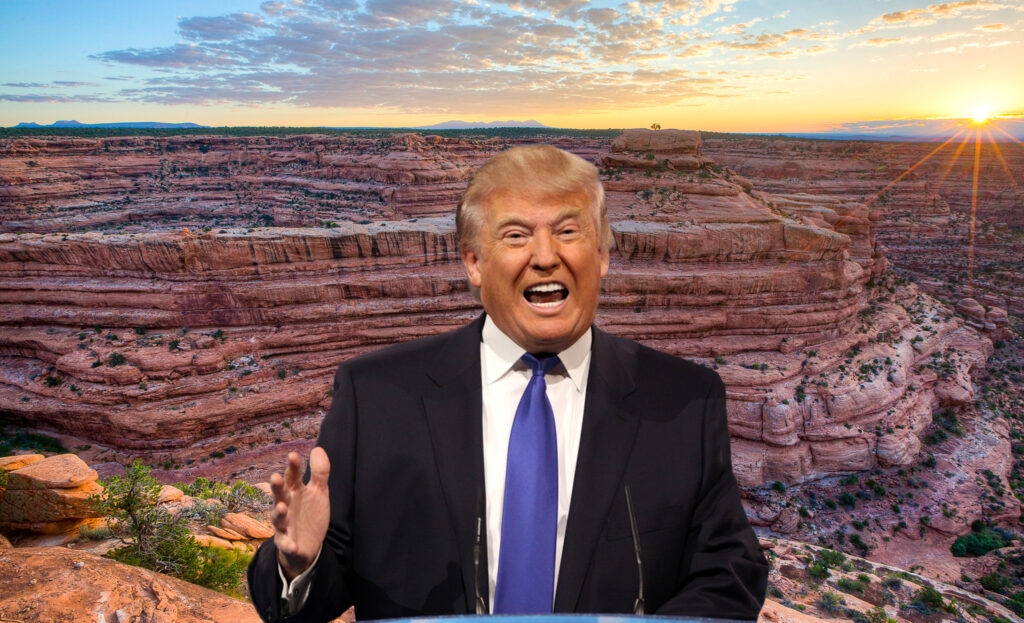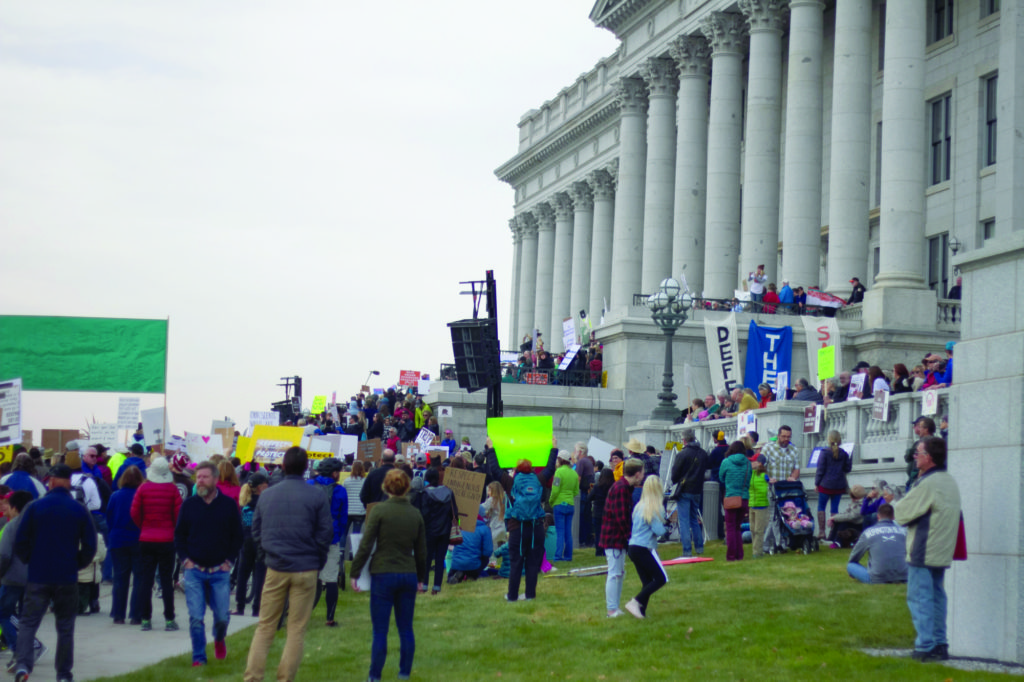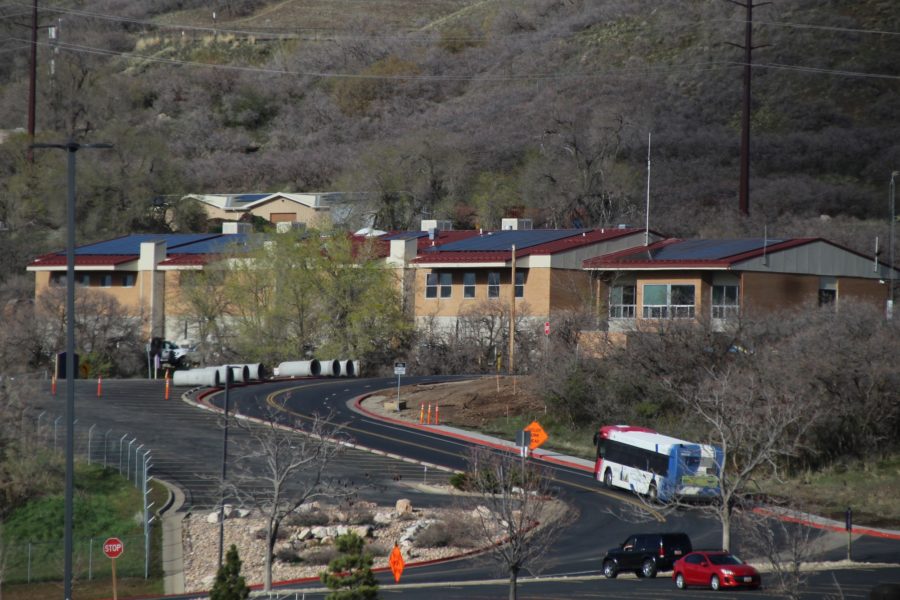
Two national monuments in Utah have become five smaller and less inclusive national monuments.
Grand Staircase Escalante National Monument was reduced from 1.9 million acres to around 1 million acres and into three separate designations: Grand Staircase, Kaiparowits Plateau and Escalante Canyons. Bears Ears National Monument was reduced by almost 85 percent, from 1.35 million acres to 228,337 acres and became Shah Jáa and Indian Creek.
The move marked the largest slash of monument lands since the Antiquities Act was passed in 1906 and the first change to a national monument in over 50 years. The unprecedented revision opens room for questions and speculation about the legality of such changes.
Hours after President Donald Trump announced the shrinking of Bears Ears and Grand Staircase Escalante, a lawsuit was introduced by a collective of 11 environmental activist groups — The Wilderness Society, Defenders of Wildlife, Natural Resources Defense Council, Southern Utah Wilderness Alliance, Grand Canyon Trust, Great Old Broads for Wilderness, Western Watersheds Project, WildEarth Guardians, Sierra Club and Center for Biological Diversity — calling the decision illegal and unconstitutional.
Three subsequent lawsuits introduced to DC federal courts also challenge the rescission of the monument designations, naming President Trump and Secretary of the Interior Ryan Zinke as defendants.
Outdoor retail brand Patagonia has signed on with Access Fund, Friends of Cedar Mesa, Conservation Lands Foundation, Archeology Southwest and others to sue Trump and Zinke on grounds the reduction allows “direct and immediate harm” to the sensitive paleontological and archaeological sites within the original boundaries of Grand Staircase Escalante and Bears Ears. The suit also mentions the rock climbing and outdoor recreation opportunities that would be lost by reducing the monument boundaries.
Two starkly contrasting opinions on the matter of the national monument designation and application have emerged in prominence and have grown into hyperbole. Monument supporters have called the reductions outright illegal.
On the other hand, opponents of Grand Staircase Escalante and Bears Ears, as well as other monuments across the western United States, object to what they see as an abuse of power and “land grabs.”
Utah Representative Rob Bishop famously called the Antiquities Act “the most evil act ever invented” after telling anyone who supported the legislation, as written to “Die. I mean, stupidity out of the gene pool.”
Much of Bishop’s congressional career has focused on reducing the authority of the federal government on public lands. Bishop and other Republican politicians have long posited the state would and could better manage public lands.
When the forty-fifth president made his first appearance in Utah since taking the oath of office, he was ostensibly following his campaign promises to hear local voices and return authority to small government.
In a cryptic appraisal of his announcement, Trump said, “Public lands will once again be for public use.”
The idea of heavy-handed federal oversight and control was a sore spot for many Americans during the 2016 presidential election. This sentiment has been rooted in western state politics for decades.

Trump’s speech on December 4, 2017 rang a familiar bell for those around in July of 1980 when Ronald Reagan campaigned in the beehive state. Reagan said that Utahans could consider him a supporter of the sagebrush rebellion of the 1970s and 1980s.
In recent years, a modern iteration of the rebellion has grown in prominence. The Bundy ranching family from Nevada and their 2014 standoff with federal agents over unpaid grazing fees, culminating in the armed occupation of the Malheur National Wildlife Refuge in 2016, represents this carryover.
Modern rebels have found an audience with Republican politicians in recent years as they continue to push the notion that the federal government is mismanaging public lands. If this claim is true, it could be because the Department of the Interior has been stifled by congressional leadership and by the interior secretary himself.
Salt Lake City resident Caroline Gleich, a professional athlete and environmental activist, spoke about her April 2017 lobbying trip to Washington D.C. with Access Fund to advocate for the national monuments and public lands.
After visiting the Department of the Interior offices, Gleich noted an upsetting scene.
“There were so many spaces in the Department not filled,” Gleich said. “There’s not enough staff to even consider monuments.”
Gleich also lamented the lack of effort and transparency from Senator Orrin Hatch while on her visit. The senator did not make an appearance, but sent his staffer who told Gleich, “You aren’t going to like what is going to happen with Bears Ears.”
It left Gleich disconcerted. “The fact that he couldn’t sit down for 20 minutes goes to show that he doesn’t have much interest in hearing what we have to say,” Gleich said.
Gleich also pointed to the long history Utahans have of not trusting the federal government in such matters, considering it as a major obstacle to creating an understanding and substantive dialogue among what has become a polarized debate over what is, objectively, common ground.
Feelings and emotions run deep in the issue of public lands in the west. The outcome of the national monuments administration and boundaries will ultimately come down to the courts.
The property clause of the Constitution gives exclusive authority over public lands to Congress.
“No comparable grant of power over our public lands was made to the president. Congress must therefore delegate power over the public lands to the president before he can act in this arena,” John Ruple, an attorney, associate professor at the S.J Quinney College of Law at the University of Utah and former policy analyst for Utah Governor Gary Herbert’s Public Lands Office, said.
Ruple pointed out several problems with Trump’s national monument order.
“The Antiquities Act was passed because Congress was not nimble enough to address the often rapidly developing threats to our national treasures,” Ruple said. “While swift presidential action may be needed to protect irreplaceable resources, there’s no similar urgency demanding monument reduction.”
One argument for precedence is that national monuments have been reduced in the past, albeit not to the extent to which Trump acted in December. Ruple said this doesn’t hold up to scrutiny, however, because previous reductions, such as President Eisenhower’s 1956 “Revising the Boundaries of Great Sand Dunes National Monument, Colorado,” or President Truman’s 1945 “Eliminating Certain Lands from the Santa Rosa Island National Monument,” were never challenged in court.
Previous revisions were done in response to national security or as corrections to poor quality boundary descriptions and surveys or for omitting homesteads or mining claims predating designation of the monument.
“There has never the kind of wholesale, politically motivated reduction that we are talking about today,” Ruple said.
In 1976, the Federal Lands Policy and Management Act clarified a systematic outline for management of the public lands which account for 12 percent of all lands in the U.S. and two-thirds of lands in Utah. The FLPMA established the multiple use, sustained yield, or “MUSY,” standard of management, as well as requiring fair market value be received for lands sold or leased.
The FLPMA also restricted the president’s implied authority over public lands.
“In the 111 years since enactment of the Antiquities Act,” Ruple said, “Congress has repeatedly voted down bills that would have authorized the president to revise or reduce national monuments, indicating both that they knew he lacked that power and that they did not intend to empower him to act in that manner.”
Last year, during Secretary Zinke’s review of 27 national monuments, the Utah Legislature’s Commission for the Stewardship of Public Lands issued a statement that the newly-designated Bears Ears National Monument disrupted operations of extraction interests and therefore undermined national security.
White Mesa, located in southeastern Utah, is home to the last operating uranium mill in the United States. Energy Fuels, Inc. owns the Daneros mine, just outside of Blanding, Utah. Energy Fuels claims that while Daneros is outside of the monument boundaries, the access road runs through Bears Ears and that activists would use the monument status to attack the operations of the mine.
The expressions from Energy Fuels have been rebuked as a mis-characterization of monument supporters. President Obama specifically considered the White Mesa operations when designating the boundaries of Bears Ears, yielding to concerns of locals and mining interests.
The week following Trump’s monument revisions, Utah Representative Chris Stewart introduced H.R. 4558, ratifying the new monument designations, as well as establishing the “Escalante Canyons National Park and Preserve.”
Scott Groene, executive director of the Southern Utah Wilderness Alliance, called Stewart’s bill a “a brazen handout to the extremist voices who wish to eliminate federal control of public lands that belong to all.”
In his statement, Groene described poor land management and dirty energy as the winners, warning that, “The bill, with its throwaway National Park designation, is a bait and switch. No one should bite.”
Utah Representative John Curtis introduced a bill as well, H.R. 4532, as an attempt to ratify Trump’s revision to Bears Ears. The bill creates a management council comprised of local officials, along with reduced tribal representation.
In effort to reign in the presidential authority granted in the Antiquities Act, Rep. Bishop, who also chairs the House Natural Resource Committee, introduced a bill in October limiting the reasons for which a national monument can be designated and requiring approval from local officials for any designation larger than 10,000 acres.
In the fight for administration and management of federally-managed public lands, there are layers of questions. The legal battle over the monuments will take several years and millions of dollars.
Other influencing factors such as the understaffed Department of the Interior and unappointed judges will compound the difficulties of reconciling the legality of multi-faceted efforts and implementation of judicial decisions.
Much of the disagreement may result from a lack of understanding. Misinformation regarding climbing and recreation access as well as wood gathering and tribal activities has been disseminated, leading to hostile and defensive rhetoric.
Gleich recalled visiting with citizens from Bluff, Utah, many of whom refused to work with the Inter-Tribal Coalition and Secretary Sally Jewell when she visited to investigate Bears Ears as a potential monument.
Gleich said that although the lack of communication and understanding was a barrier, she grasped that many of the monument area locals were mostly afraid of losing their livelihood and lifestyle.
“There’s not a lot of upward mobility outside of the city,” Gleich said. “But Bears Ears is not causing a loss of jobs in rural Utah.”
And as to what is killing jobs, Gleich said “Globalization.”





















